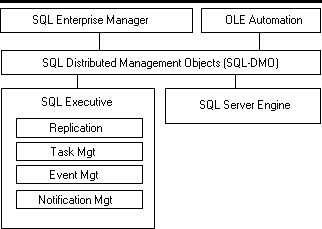
As applications become less centralized and more distributed, managing multiple, distributed databases becomes more difficult. Graphical tools, like the Microsoft SQL Server user interface, SQL Enterprise Manager, are one part of the solution because they allow you to administer multiple distributed servers from a central console. Another critical part of the solution is a robust scripting language for automating repetitive administrative tasks.
SQL Distributed Management Objects (SQL-DMO) defines all aspects of the Microsoft SQL Server database engine and services. SQL-DMO is part of a comprehensive framework called SQL Distributed Management Framework (SQL-DMF), which is an integrated framework of objects, services, and components used to manage Microsoft SQL Server. SQL-DMF provides a flexible and scalable management framework that is adaptable to your specific needs. SQL-DMF reduces the need for user-attended maintenance tasks, such as database backup and alert notification, by providing services that interact directly with SQL Server.
All the key components of SQL-DMF are core elements of SQL Server. SQL-DMF enables you to manage the SQL Servers in your enterprise by allowing you to define scenarios and corrective actions and to trigger either alerts to notify someone of the problem or tasks to correct the problem.
The following illustration shows the relationship among the SQL-DMF components.

At the lowest level of this framework, SQL-DMF provides direct access to the SQL Server engine and to services executed from the command prompt using Transact-SQL. The second level of the framework is a set of distributed management objects that provides an object interface to the SQL Server engine and services. The top level of the framework is a graphical administration tool, SQL Enterprise Manager, that provides an interface for managing a multiple-server environment. The framework also provides services for replication, scheduling, and creating alerts.